DENSITY ALTITUDE
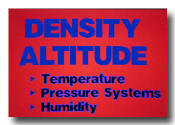 Experienced
pilots sometimes get into trouble when dealing with the effects of
density altitude. It's not that these pilots do not know what
density altitude is, it's just that they become complacent. Remember
... Complacency kills!
Experienced
pilots sometimes get into trouble when dealing with the effects of
density altitude. It's not that these pilots do not know what
density altitude is, it's just that they become complacent. Remember
... Complacency kills!
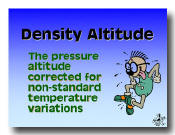 Federal
Aviation Regulation 91.116 "Pre-flight Action" requires that a pilot
check the density altitude ...
Federal
Aviation Regulation 91.116 "Pre-flight Action" requires that a pilot
check the density altitude ...
91.116 (b) For any
flight, runway lengths at airports of intended use, and the
following takeoff and landing distance information ... other
reliable information appropriate to the aircraft, relating to
aircraft performance under expected values of airport elevation and
runway slope, aircraft gross weight, and wind and temperature.
 Density
altitude is a term that sometimes causes confusion to the
uninitiated. A high density altitude is NOT a good thing. Density
altitude is defined as the pressure altitude corrected for
non-standard temperature variations. And while this is a correct
definition, my definition is perhaps more appropriate: DENSITY
ALTITUDE IS THE ALTITUDE THE AIRPLANE THINKS IT IS AT, AND PERFORMS
IN ACCORDANCE WITH THIS COMPUTED VALUE.
Density
altitude is a term that sometimes causes confusion to the
uninitiated. A high density altitude is NOT a good thing. Density
altitude is defined as the pressure altitude corrected for
non-standard temperature variations. And while this is a correct
definition, my definition is perhaps more appropriate: DENSITY
ALTITUDE IS THE ALTITUDE THE AIRPLANE THINKS IT IS AT, AND PERFORMS
IN ACCORDANCE WITH THIS COMPUTED VALUE.
Suppose an airport is situated at an elevation of 3,000 feet. It is possible with a low pressure system and hot temperatures for this airport to have a density altitude of more than 6,000 feet due to the effects of the pressure and temperature. An airplane operating at the 3,000-foot airport on a day with a 6,000-foot density altitude would have the performance normally found when flying at 6,000 feet during a day with standard conditions.
DENALT COMPUTER
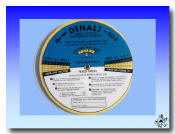 Density
altitude can be computed on a density altitude chart, flight
computer, electronic flight calculator or by rule of thumb. Density
altitude gives us some idea about the expected performance of the
airplane, but only if you apply the information to the performance
charts found in the owner's manual or POH (Pilot's Operating
Handbook). The DENALT performance computer has a "write-in" area for
the sea level takeoff distance and rate of climb. When the
temperature is aligned with the pressure altitude, it provides
values that can be multiplied by the sea level takeoff and sea level
rate-of-climb to predict the expected performance under current
density altitude conditions.
Density
altitude can be computed on a density altitude chart, flight
computer, electronic flight calculator or by rule of thumb. Density
altitude gives us some idea about the expected performance of the
airplane, but only if you apply the information to the performance
charts found in the owner's manual or POH (Pilot's Operating
Handbook). The DENALT performance computer has a "write-in" area for
the sea level takeoff distance and rate of climb. When the
temperature is aligned with the pressure altitude, it provides
values that can be multiplied by the sea level takeoff and sea level
rate-of-climb to predict the expected performance under current
density altitude conditions.
This special DENALT calculator has information for both fixed-pitch propeller or constant-speed propeller airplanes. The sea level performance can be written at the bottom. The temperature is selected at the top center, then the pressure altitude is selected along the center, to the left your will find take-off factors and to the right is a rate-of-climb percentage. Multiply the sea level performance by the factors and obtain the expected performance of the airplane.
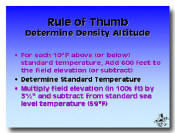 A
surprisingly accurate rule of thumb (usually any error will be less
than 200-300 feet) for determining the density altitude is easy to
remember. For each 10-degrees Fahrenheit above standard temperature
at any particular elevation, add 600 feet to the field elevation.
(And, conversely for each 10-degrees F below standard temperature,
subtract 600 feet from the field elevation.)
A
surprisingly accurate rule of thumb (usually any error will be less
than 200-300 feet) for determining the density altitude is easy to
remember. For each 10-degrees Fahrenheit above standard temperature
at any particular elevation, add 600 feet to the field elevation.
(And, conversely for each 10-degrees F below standard temperature,
subtract 600 feet from the field elevation.)
Standard temperature at sea level is 59-degrees Fahrenheit. For elevations above sea level, subtract 3.5 degrees per thousand feet of elevation from the sea level temperature of 59 degrees.
For example, at Jackson, Wyoming the elevation is 6,444. Multiply 6.444 times 3.5 for 22.55. Subtract this from 59 (59-22.55) for 36.45. The standard temperature at Jackson is 36.5 degrees. If the existing temperature is 80 degrees, subtract (80-36.5 = 43.5). Divide this difference by 10 degrees (for each 10-degrees F above standard), and multiply 4.35 times 600 (600 feet per 10 degrees) which equals 2,610. Add 2,610 to the field elevation (6,444) for a density altitude of 9,054. Under the existing conditions (of our example), the airplane will perform as it would on a standard day at 9,054 feet elevation.
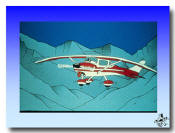 Density
altitude not only affects the takeoff distance and rate of climb,
but it also applies to the service ceiling of the airplane while
flying en route. It may be possible to fly an airplane with a
service ceiling of 12,650 feet toward mountains that top out at
10,000 feet, yet because of density altitude the airplane is unable
to clear the mountains (unless you can find some anabatic or
mechanical lift).
Density
altitude not only affects the takeoff distance and rate of climb,
but it also applies to the service ceiling of the airplane while
flying en route. It may be possible to fly an airplane with a
service ceiling of 12,650 feet toward mountains that top out at
10,000 feet, yet because of density altitude the airplane is unable
to clear the mountains (unless you can find some anabatic or
mechanical lift).
RULE OF THUMB
A simple rule of thumb for determining takeoff distance exists that helps you deal with density altitude during takeoff. The only problem is that it does not guarantee rate of climb after takeoff. It does, however, insure that you will be able to takeoff in the distance available for the runway involved. (Takeoff Distance)
|
|
|

